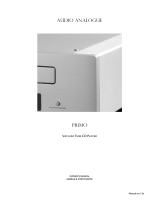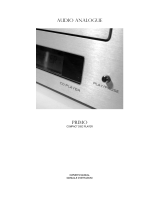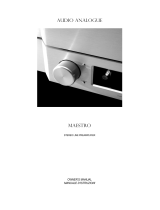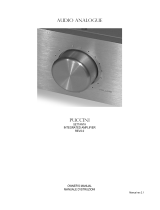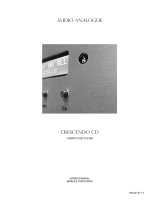Page is loading ...
Page is loading ...
Page is loading ...

4
INTRODUCTION
AUDIO ANALOGUE does not take any responsibilities in the following cases:
Whenever the operational procedures related to the use and the maintenance of the equipment as described in this manual are not
respected.
Whenever damages to the equipment occur because of fixing and modifications made form non-authorized staff or because of
normal deterioration of the system.
No part of this manual can be reproduced by any means, transmitted or copied for private or public use without private authorization
from AUDIO ANALOGUE.
The information contained in this manual is related to the data kept by AUDIO ANALOGUE at the moment of the issue o f this
publication; AUDIO ANALOGUE has the right to make changes to this document without prior notice.
The equipment has been projected and manufactured according to the Regulations of the Community 89/336/CEE and is marked CE.
This equipment can’t be used for different purposes other than those for which it has been manufactured.
AUDIO ANALOGUE does not take any responsibilities for accidents or damages due to improper use of the equipment.
WARNING
Please do respect the safety standards contained in this manual before starting to operate the equipment.
Do not open the equipment. No further interventions than those described in this manual should be made. For technical assistance,
please consult a qualified technician or an AUDIO ANALOGUE dealer.
Not respecting the instructions contained in this manual will invalidate the terms and conditions of the guarantee.
NECESSARY PRECAUTIONS FOR SAFETY AND MAINTENANCE
ATTENTION: before starting any operation, use or maintenance of the equipment it is strictly necessary to understand the following
manual.
To avoid any accidents or hazards it is necessary to follow the following regulations.
Activate the equipment only prior checking if the installation has been properly made, and if it is related to the instructions contained
in this manual.
Avoid installing the equipment in places subjected to extremely high temperatures or humidity.
Check that the labels containing information about safety are always visible and in good conditions.
Ensure to not obstruct ventilation, to avoid excessive overheating. The equipment should be kept to a minimal distance of 15 cm
from any object and not to place on carpet or other soft surfaces. Also the installation close to radiators or in close environments
without ventilation should be avoided.
Do not switch on the equipment until it has not been correctly and completely installed.
Only supply the equipment with the kind of the electric supply as stated on the appropriate label. If in doubts about the kind of supply
available, please consult an expert technician for technical assistance.
The equipment needs to be wired to an earth terminal. The external case is metal made; a defective connection with the earth may
be dangerous.
In case damages occurs to the supply cable, it should be immediately replaced with the same kind of cable. This operation should be
only made prior to disconnecting the main supply.
Do not place objects on the supply cable and check that this is not positioned in way through. The cable should not be knotted or
curly.
Replace the fuses always with other of the same kind.
Do not use the equipment close to the water or other liquids. If liquid entered the equipment, the plug should be disconnected from
the socket avoiding to touch the metal parts. Competent technical staff should be asked to check the equipment before operating it
again.
Do not place recipients containing liquids on the equipment. Even when it is switched off.
Keep the equipment far from sources of heat such as the solar light, kitchens, radiators etc…
Always unplug the supply cable during rainy weather.
Always Switch off and unplug the supply cable before cleaning the equipment externally.: this operation should be made using a dry
and soft cloth. Never use alcohol based cleaning material.
If the amplifier was carried from an extremely cold environment to and extremely hot one, it could create internal condensation,
causing possible bad functioning.
If this occurs, please wait for at least an hour before using it again, to allow it to gradually reach room temperature.
When not used for long periods, please unplug the equipment.
INSTRUCTIONS TO PUT IT OUT OF SERVICE
Consult qualified staff
Follow the regulations of the current legislation regarding recycling and waste disposal.
Page is loading ...

6
1
2 3 4
6
1
2 3 4
5
Front panel
1) POWER. By pushing this button the unit is turned on/off.
2) SELECT. Inputs selector. It allows selecting the desired source. One of the green leds on its right indicates the selected
source.
3) PH/1,2,3,4,5. Green leds that indicate the selected input. In 1 may be used as phono input thanks to the optional board. A fix
light indicates the selected source and the normal operative status of the unit, while a blinking light indicates that the unit is in
the mute mode.
4) Volume knob. It rotates just for a few degrees because it operates on an interrupter. Do not force the knob. A slight clockwise
rotation increases the volume, an anti-clockwise rotation decreases it. Attenuation level is shown by leds.
5) Volume leds. Sixteen green leds around the volume knob progressively indicate the volume level.
6) IR receiver
Descrizione del pannello frontale
1) POWER. Pulsante di accensione e spegnimento dell’apparecchio.
2) SELECT. Selettore ingressi. Permette di selezionare la sorgente da ascoltare visualizzandola tramite l’accensione uno dei
cinque led verdi posti alla sua destra.
3) PH/1,2,3,4,5. Led verdi per l’indicazione dell’ingresso selezionato. Il primo ingresso può essere utilizzato come phono grazie
alla scheda opzionale. La luce fissa indica la sorgente selezionata e il funzionamento dell’apparecchio in modalità normale,
mentre la luce lampeggiante indica che è stato attivato il muting.
4) Manopola del volume. Essa ruota soltanto di pochi gradi perchè agisce su un interruttore e non deve quindi essere forzata.
Una lieve rotazione in senso orario determina l’aumento di volume, quella in senso antiorario la sua diminuzione. Il livello di
attenuazione viene visualizzato dal numero di led accesi intorno ad essa.
5) Led per l’indicazione del volume. Sedici led verdi posti attorno alla manopola del volume si accendono in quantità
proporzionale al livello di volume impostato.
6) Ricevitore IR.

7
1 2
3
4
5
6
7
Back panel
1) RIGHT SPEAKER OUT. Right speaker out connector.
2) LEFT SPEAKER OUT. Left speaker out connector.
3) EARTH. Turntable ground connector (to be used only when phono input is in use)
4) PH/1. Phono/line input, configurable from set-up.
5) 2,3,4,5. Line input.
6) TAPE OUT. Tape out.
7) Power cord.
Descrizione del pannello posteriore
1) RIGHT SPEAKER OUT. Connettori di uscita right.
2) LEFT SPEAKER OUT. Connettori di uscita left.
3) EARTH. Connettore per collegare il filo di terra del giradischi nel caso in cui venga utilizzato l’ingresso phono.
4) PH/1. Ingresso linea oppure phono nel caso in cui l’amplificatore sia dotato di scheda phono MM/MC opzionale.
5) 2, 3, 4, 5. Ingressi linea.
6) TAPE OUT. Uscita tape.
7) Cavo di alimentazione di rete.

Description of the remote controller
AMPLIFIER Functions
• IN+: it changes the selected source.
• VOLUME+: it increases the volume of the unit.
• IN-: it changes the selected source.
• VOLUME-: it decreases the volume of the unit.
• MUTE: it activates/de-activates the mute function.
Remote controller - Descrizione del telecomando
Funzioni dell’AMPLIFICATORE
•
IN+: cambia la sorgente selezionata.
•
VOLUME+: aumenta il volume dell’apparecchio.
•
IN-: cambia la sorgente selezionata.
•
VOLUME-: diminuisce il volume dell’apparecchio
•
MUTE: attiva/disattiva la funzione mute

9
Unpacking and checking Primo package
Carefully open the package to avoid damaging the content. The package should contain:
•
1 Primo Settanta
•
1 remote control
•
2 AAA batteries
•
1 instruction manual
If one of the items listed above is missing, please contact your Audio Analogue retailer. After extracting the smallest items from the
package, pull out the unit carefully. Separate the package from the anti-shock expanded-foam protections. If batteries are not
already placed in the remote controller battery slot, open the slot; insert batteries according to the indicated polarity, then close the
battery slot.
Apertura e ispezione dell’imballo
Aprire la scatola di cartone con cautela per non danneggiare il contenuto. L’imballo deve contenere:
•
Un Primo Settanta
•
Un telecomando
•
Due batterie AAA
•
Questo manuale
Se qualcuno degli oggetti sopra elencati dovesse mancare, contattate il Vostro rivenditore Audio Analogue di fiducia.
Dopo avere estratto le parti di minori dimensioni, estrarre con cautela l’apparecchio dall’imballo. Separare l’imballo dalle imbottiture
antiurto in schiuma espansa. Se le batterie non si trovano già all’interno del telecomando, aprire il coperchio del vano portapile del
telecomando ed inserirle nelle posizioni corrette; quindi chiudere il coperchio del vano portapile.
Where to place Primo Settanta
Primo Settanta is a complex unit that may generate a large quantity of heat. Please locate the unit in a well-ventilated place. In
particular, you should leave at least 5cm around and above the unit and avoid placing it close to heat sources (radiators, heaters,
amplifiers, television sets).
Scelta del luogo in cui posizionare il Primo Settanta
Il Primo Settanta è un apparecchio che può generare calore in misura non trascurabile. Per questo motivo è consigliabile
posizionarlo laddove sia garantita una corretta circolazione d’aria. In particolare, è opportuno garantire uno spazio sufficiente
attorno e sopra l’apparecchio (almeno 5cm), ed evitare posizionamenti vicino a fonti di calore (termosifoni o stufe, amplificatori di
potenza, televisori).
Plugging and connecting Primo Settanta
Before to connect Primo Settanta to a sound source, please be sure that they’re both unplugged from wall outlets. First of all, hook
up the sound sources outs to the Primo Settanta ins. Connect recorder in to Primo Settanta tape out. Please use only high-quality
cords with gold plated connectors.
As the second step, connect Primo Settanta output to the speakers cable.
At last, plug the Primo Settanta power cord into the wall outlet.
Collegamento del Primo Settanta
Prima di collegare il Primo Settanta alle sorgenti, verificare che tutti gli apparecchi siano scollegati dalla rete elettrica.
Per prima cosa, collegare le uscite delle sorgenti audio agli ingressi del Primo Settanta. Collegare l’ingresso del registratore (se lo si
possiede) all’uscita tape del Primo Settanta. Utilizzare possibilmente cavi della migliore qualità, terminati con connettori dorati.
Quindi, collegare le uscite del Primo Settanta ai diffusori.
Infine, collegare la spina del cavo di alimentazione ad una presa di rete.
Notes on Primo Settanta power plugging
Primo Settanta has to be plugged to the electric installation grounding link to guarantee user’s safety and maximize sound quality.
Actually, the grounding link is the way to eliminate noise and dispersion: that’s why the power cord has the grounding prong. It is
preferable not to interrupt grounding link (for example, with a two-prong adapter) unless this operation is necessary to avoid further
Page is loading ...

11
Il pulsante di mute sul telecomando permette di attenuare il livello di ascolto di 20dB. Con un normale livello di ascolto, ciò equivale
a passare ad un livello di sottofondo musicale. Questa funzione è utile qualora sia improvvisamente necessario abbassare il volume
di ascolto, per esempio per rispondere la telefono o per parlare con qualcuno o ancora quando si desidera cambiare il CD nel
lettore. Per volumi molto bassi di ascolto è possibile che l’attivazione del mute provochi il silenziamento totale dei due canali. La
disattivazione del mute ripristinerà comunque il normale livello di ascolto.
Inputs selection
You may select your desired audio input by pushing the “SELECT” button on the front panel or the “IN+/IN-“ buttons on the remote
control.
Selezione dell’ingresso per l’ascolto
La selezione dell’ingresso audio desiderato per l’ascolto avviene tramite la pressione del pulsante SELECT sul pannello frontale
oppure dei pulsanti IN+ o IN- del telecomando.
Note on Tape output
Caution, when the volume is in position 0, the Tape output is disconnected
Nota sull'uscita TAPE
Attenzione, quando il volume è a livello'0' l'uscita TAPE è disattivata
Phono board (optional)
A feature that makes Primo Settanta a very flexible unit is the possibility to install a special board (1) that transforms Line input 1
into a Phono input. If you want to connect Primo Settanta to a record player, please ask for the optional phono board and install it
according to the instructions below.
Scheda Phono (opzionale)
Una caratteristica che rende il Primo Settanta versatile è la possibilità di inserire all’interno dell’apparecchio una scheda che
trasforma l’ingresso linea 1 in ingresso phono. Tutti gli utenti in possesso di questo amplificatore che desiderano collegarlo ad un
giradischi possono richiedere la scheda phono opzionale da integrare al resto del circuito seguendo le istruzioni sotto riportate.
1 2
3
Page is loading ...

13
Specifications
Parameter Measurement conditions Value
Channels: - 2
Line gain: 20Hz-20kHz 12dB
Frequency response
Attenuazione 0dB
Attenuazione –10dB
103kHz +0/-3dB
103kHz +0/-3dB
Noise level:
Attenuation 0dB
Band limits 0Hz-48kHz
-98dBV
Signal/noise ratio
22Hz-22kHz
Vout: 30dBV
84dBV
Power requirement: - 100V/240 50-60Hz
Power consumption: - 200VA
Output power: 20Hz-20kHz, 8Ohm, two piloted channels 70W @0.7%
Specifiche Tecniche
Parametro Condizioni di misura Valore
Numero di canali: - 2
Guadagno stadio linea 20Hz-20kHz 12dB
Risposta in frequenza
Attenuazione 0dB
Attenuazione –10dB
103kHz +0/-3dB
103kHz +0/-3dB
Livello di rumore
Attenuazione 0dB
Limiti di banda 0Hz-48kHz
-98dBV
Rapporto segnale/rumore
22Hz-22kHz
Vout: 30dBV
84dBV
Alimentazione: - 100V/240V 50-60Hz
Assorbimento: - 200VA
Potenza di uscita: 20Hz-20kHz, 8Ohm, due canali pilotati 70W @0.7%

14
TROUBLESHOOTING
Symptom Cause Remedy
Power cord incorrectly plugged Make sure the power cord is correctly
plugged into the wall outlet
No leds on
No sound
Burned-out fuses Contact your Audio Analogue retailer for
fuse check and substitution
Low volume Increase volume
Faulty or incorrectly plugged signal
connectors between Primo Settanta and
the sources
Check cords and their connection
Off or incorrectly selected source Check if the source is on and active and if
it is correctly selected using the in
selector
In led on
No sound
Faulty or incorrectly plugged power
connectors between Primo Settanta and
the speakers
Check cords and their connection
In leds are on, volume control working but
volume leds are off or in leds are off but
volume leds are on
Faulty or incorrectly plugged front panel Contact your Audio Analogue retailer for
connections check and front panel
substitution
Recording is impossible Incorrectly selected source Select the right source using the
recording selector
No battery/ worn-out battery Place/replace battery (2 ‘AAA’ batteries) Remote controller doesn’t work
You’re standing too far or on an
exceeding angle from the front panel
Get closer to the unit or reduce angle
If the suggested remedies should not work or the problem is not shown in the list above, please contact your local Audio
Analogue retailer.
RICERCA GUASTI
Sintomo Causa Rimedio
Cavo di alimentazione non correttamente
collegato alla rete
Controllare che la spina del cavo di rete
sia ben inserita nella presa di rete
Nessun led acceso
Nessun suono
Fusibile bruciato all’interno
dell’apparecchio
Contattare il vostro rivenditore Audio
Analogue per una verifica ed eventuale
sostituzione del fusibile
Volume regolato al minimo Alzare il volume
Cavi di segnale tra sorgente e Primo
Settanta non connessi correttamente
oppure difettosi
Controllare lo stato dei cavi e/o la corretta
connessione
Sorgente spenta o non selezionata
correttamente
Controllare che la sorgente sia accesa e
attiva, e che sull’amplificatore sia
selezionato l’ingresso a cui la sorgente è
collegata
Led di un ingresso acceso
Nessun suono
Cavi di potenza tra Primo Settanta e
diffusori non connessi correttamente
oppure difettosi
Controllare lo stato dei cavi e/o la corretta
connessione
Led di ingresso acceso, il controllo del
volume funziona ma led indicatori spenti,
oppure led degli ingressi spenti e
indicatori di volume accesi
Scheda frontale non collegata
correttamente oppure difettosa
Contattare il vostro rivenditore Audio
Analogue per una verifica dei
collegamenti ed eventuale sostituzione
della scheda
La registrazione è impossibile Sorgente non correttamente selezionata Selezionare la sorgente giusta con il
selettore degli ingressi
Batterie scariche o mancanti Inserire o sostituire le batterie (2 ministilo
tipo ‘AAA’)
Il telecomando non funziona
Eccessiva distanza dal pannello frontale
dell’apparecchio o angolo non corretto
Avvicinarsi di più all’apparecchio o
cambiare angolo
Se i rimedi suggeriti non dovessero funzionare oppure il problema non è riportato nella lista, contattate il vostro
rivenditore Audio Analogue

Attention: Your product is marked with this symbol. It
means that used electrical and electronic products
should not be mixed with general household waste.
There is a collection system for these products.
Attenzione: il dispositivo è contrassegnato da questo
simbolo, che segnala di non smaltire le
apparecchiature elettriche ed elettroniche insieme ai
normali rifiuti domestici. Per tali prodotti è previsto un
sistema di raccolta a parte.
A. INFORMATION ON DISPOSAL FOR USERS (PRIVATE HOUSEHOLDS)
1 In The European Union
Attention: If you want to dispose of this equipment, please do not use the ordinary dust bin.
Used electrical and electronic equipment must be treated separately and in accordance with legislation that requires
proper treatment, recovery and recycling of used electrical and electronic equipment.
Following the implementation by member states, private households within the EU states may return their used electrical
and electronic equipment to designated collection facilities free of charge*. In some countries* your local retailer may also
take back your old product free of charge if your purchase a similar new one.
*) Please contact your authority for further details.
If your used electrical or elctronic equipment has batteries or accumulator, please dispose of these separately before and
according to local requirements.
By disposing of this product correctly you will help ensure that the waste undergoes the necessary treatment, recovery
and recycling and thus prevent potential negative effects on the environment and human health which could otherwise
arise due to inappropriate waste handling.
2. In other countries outside the EU
If you wish to discard this product, please contact your local authorities and ask for the correct method of disposal.
For Switzerland: Used electrical or electronic equipment can be returned free of charge to the dealer, even if you don’t
purchase a new product. Further collection facilities are listed on the home page of www.swisco.ch or www. Sens.ch
B. Information on Disposal for Business Users
1. In the European Union
If this product is used for business purposes and you want to discard it:
Please contact your Audio Analogue dealer who will inform you about the take-back and recycling. Small products (and
small amounts) might be taken back by your local collection facilities.
For Spain: Please contact the established collection system or your local authority foer take-back of your used products.
2. In other Countries outside the EU
If you wish to discard of this product, please contact your local authorities and ask for the current method of disposal.
A. INFORMAZIONI SULLO SMALTIMENTO PER GLI UTENTI (PRIVATI)
1 Nell’Unione europea
Attenzione: Per smaltire il presente dispositivo, non utilizzare il normale bidone della spazzatura!
Le apparecchiature elettriche ed elettroniche usate devono essere gestite a parte in conformità alla legislazione che
richiede il trattamento, il recupero e il riciclaggio adeguato dei suddetti prodotti.
In seguito alle disposizioni attuate dagli Stati membri, i privati residenti nella UE possono conferire gratuitamente le
apparecchiature elettriche ed elettroniche usate a centri di raccolta designati*.
In alcuni paesi*, anche il rivenditore locale può ritirare gratuitamente il vecchio prodotto se l’utente acquista un altro nuovo
di tipologia simile.
*) Per maggiori informazioni di prega di contattare l’autorità locale competente.
Se le apparecchiature elettriche o elettroniche usate hanno batterie o accumulatori, l’utente dovrà smaltirli a parte
preventivamente in conformità alle disposizioni locali.
Lo smaltimento corretto del presente prodotto contribuirà a garantire che i rifiuti siano sottoposti al trattamento, al
recupero e al riciclaggio necessari prevenendone il potenziale impatto negativo sull’ambiente e sulla salute umana, che
potrebbe derivare da un’inadeguata gestione dei rifiuti.
2 In paesi che non fanno parte dell’UE
Se si desidera eliminare il presente prodotto,contattare le autorità locali e informarsi sul metodo di smaltimento corretto.
Per la Svizzera: Le apparecchiature elettriche o elettroniche possono essere restituite gratuitamente al rivenditore, anche
se non si acquista un prodotto nuovo. Altri centri di raccolta sono elencati sulla homepage www.swiso.ch o di
www.sens.ch.
B. INFORMAZION SULLO SMALTIMENTO PER GLI UTENTI COMMERCIALI
1. Nell’Unione Europea
Se il prodotto è impiegato a scopi commerciali. Procedere come segue per eliminarlo.
Contattare il proprio rivenditore Audio Analogue che fornirà informazioni circa il ritiro del prodotto. Potrebbero essere
addebitate le spese di ritiro e riciclaggio. Prodotti piccoli e quantitativi ridotti potranno essere ritirati anche dai centri di
raccolta locali.
Per la Spagna: Contattare il sistema di raccolta ufficiale o l’ente locale preposto al ritiro dei prodotti usati
2. In paesi che non fanno parte dell’UE
Se si desidera eliminare il presente prodotto, contattare le autorità locali e informarsi sul metodo di smaltimento corretto.

Audio Analogue
Manufactured and Distributed by:
AUDIO FUTURA spa
Via Maestri Del Lavoro 583
51015 Monsummano Terme (PT) Italy
Tel. 0572 954513 fax 0572 958099
www.audioanalogue.com - info@audioanalogue.com
/
